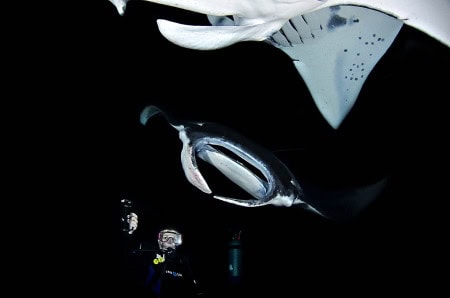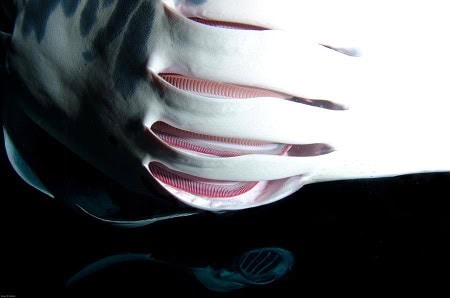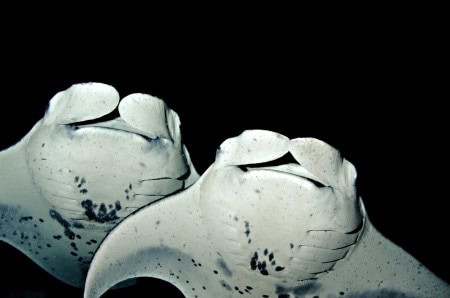
The Kona Manta Ray Dive is something really special. Swimming with the magnificent Giant Oceanic Manta Ray, Manta birostris, is an experience that is not to be missed. The largest recorded Oceanic Manta Ray was more than 25 ft (7.6 m) across from wing-tip to wing-tip and weighed over 5,300 pounds (2,400 kg). Manta Rays have a short tail and no stinging spine. They are very acrobatic and you can see them perform aerobatic flips and rolls as they glide through the water. They can even leap (breach) from the water.
Kona Manta Ray Dive Rating: 4.13 out of 5
- Visibility – moderate to good
- Access – Moderate; boat only and 25 minutes from Honokohau Marina & Small Boat Harbor, Kailua Kona
- Current – variable, minimal to strong;
- Depth to 40 ft / 12 m
- Hard/Soft Coral – Good
- Marine species variety – Moderate
- Pelagics / Mammals / Turtles / Rays – Very Good, Its all about the Giant Oceanic Manta Rays
Scuba Diving with Manta Rays can be done in a number of locations around the world. On the big island of Hawaii, diving with Manta Rays has been going on for decades. Hotels such as the Kona Surf Hotel, now the Sheraton Keauhou Bay Resort have been attracting Manta Rays for many years. Lights from the hotel shone in the water causing plankton to gather and this in turn drew the Manta Rays to feed on the plankton. Dive operators saw the opportunity to take scuba divers to these locations and began augmenting lights from the hotel or shore with underwater lights.

This has become a nightly tradition in Hawaii and it is a fantastic chance to interact with these magnificent creatures. In Kona there are two locations where you can scuba dive with the Manta Rays. The original Manata Ray dive site at the Sheraton Keauhou Bay Resort and the second is along the shore by the airport. The second site has been very “hot” lately with large numbers of Manta Rays coming most nights with record numbers occurring in late March and early April of this year (up to 37 Manta Rays on a single night dive).
Manta rays have the largest brain-to-body ratio of the sharks, rays and skates (Elasmobranchii), with ratios approaching what is expected in mammals rather than in fishes.
Old Airport Road – Kona Manta Ray Dive Site
On this Kona Manta Ray dive, we did two dives one late afternoon and saw 17 Mantas swimming along the reef and they decided to join us for a short time period of time as we cruised over the reef. Then on the night dive we had 31 different Manta Rays swimming all around us. The Mantas come to feed on plankton which is attracted to light. The dive operators give individuals flashlights to each diver and also place a number of additional lights in a box that are simply laid on the sea floor. You sit in about 35 feet of water around these “light boxes” as the Mantas “fly” around you. It is certainly a memorable dive.

The breeding behavior observed for manta rays is similar to other closely related rays. Copulation occurs near the surface, no deeper than one meter below. It begins with the male chasing the female, for up to half an hour, both often closely followed by a train of hopeful suitors. Such mating trains seem to be triggered by a full moon. The male bites the pectoral fin
and then moves its claspers into the cloaca, holding it there for one minute to one and a half while copulation takes place. The developing eggs remain inside the female’s body for possibly as long as 12 months and hatch internally so that she bears live young. The average litter size is two pups, and there is often a two year gap between births. (source – Wikipedia).
Adults are easily recognized by their large triangular pectoral fins and projecting cephalic fins, forward extensions of the pectoral fins that project anteriorly on either side of the head. Each cephalic fin is about twice as long as its base is wide. The length of each cephalic lobe, from tip to the mouth, is 14% of the disc width. They are rolled like spirals

when swimming and flattened when eating. This ray has smooth skin, a broad,rectangular terminal mouth located at the front of the head, and a tail that lacks a spine.
I highly encourage you to take advantage of the chance to scuba dive with the Mantas the next time you are on the big island of Hawaii or if you are visiting Hanifaru, a small lagoon next to an uninhabited island in the Maldives or another Manta diving location. The Kona Manta Ray dive is an awesome opportunity to meet some truly wonderful creatures.
Read other dive site reviews on my blog and see other underwater photographs on my website and follow me on Twitter @ images2inspire. The pool is open…
